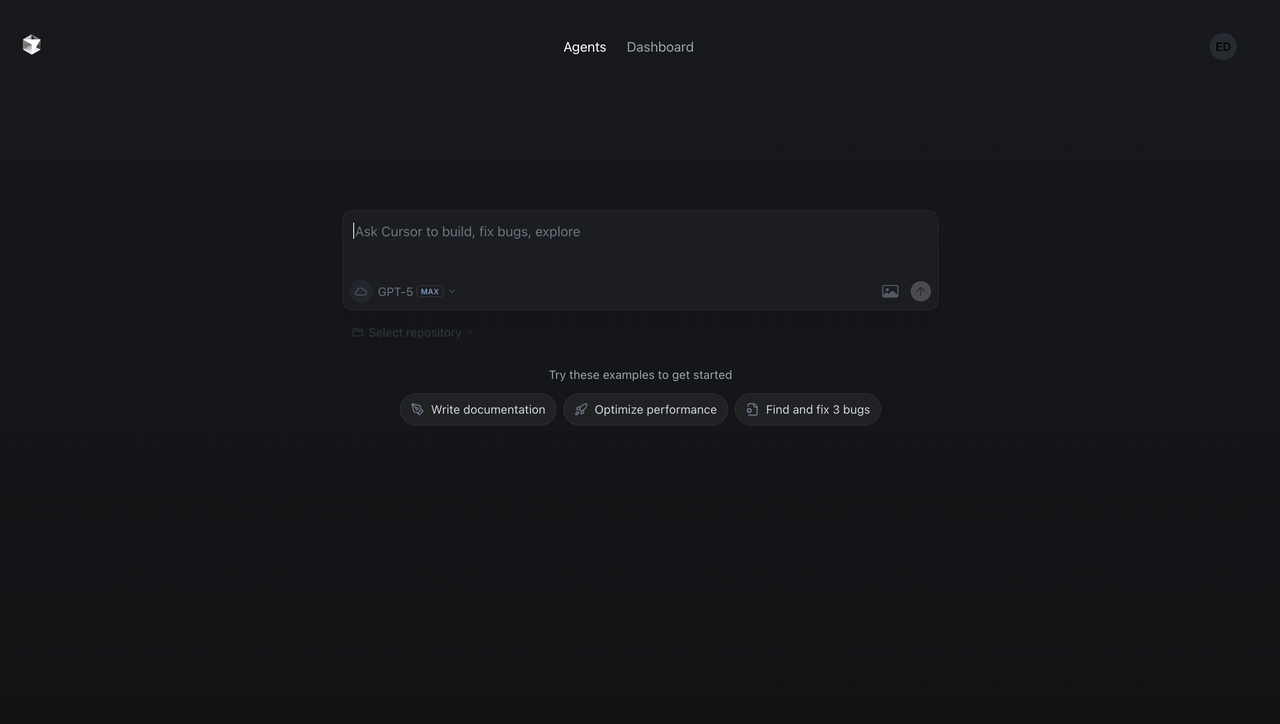Introduction
In early 2025, it felt like every day on Reddit I came across the same question: “Will Vibe Coding replace no-code?”
The buzz was everywhere—people were excitedly sharing experiments with Vibe Coding, from small features to full applications. It seemed like almost anything could be built just by having a conversation with AI.
But a few months later, the mood shifted.
One user posted: “Been vibe coding for 5 months, but went back no-code.”
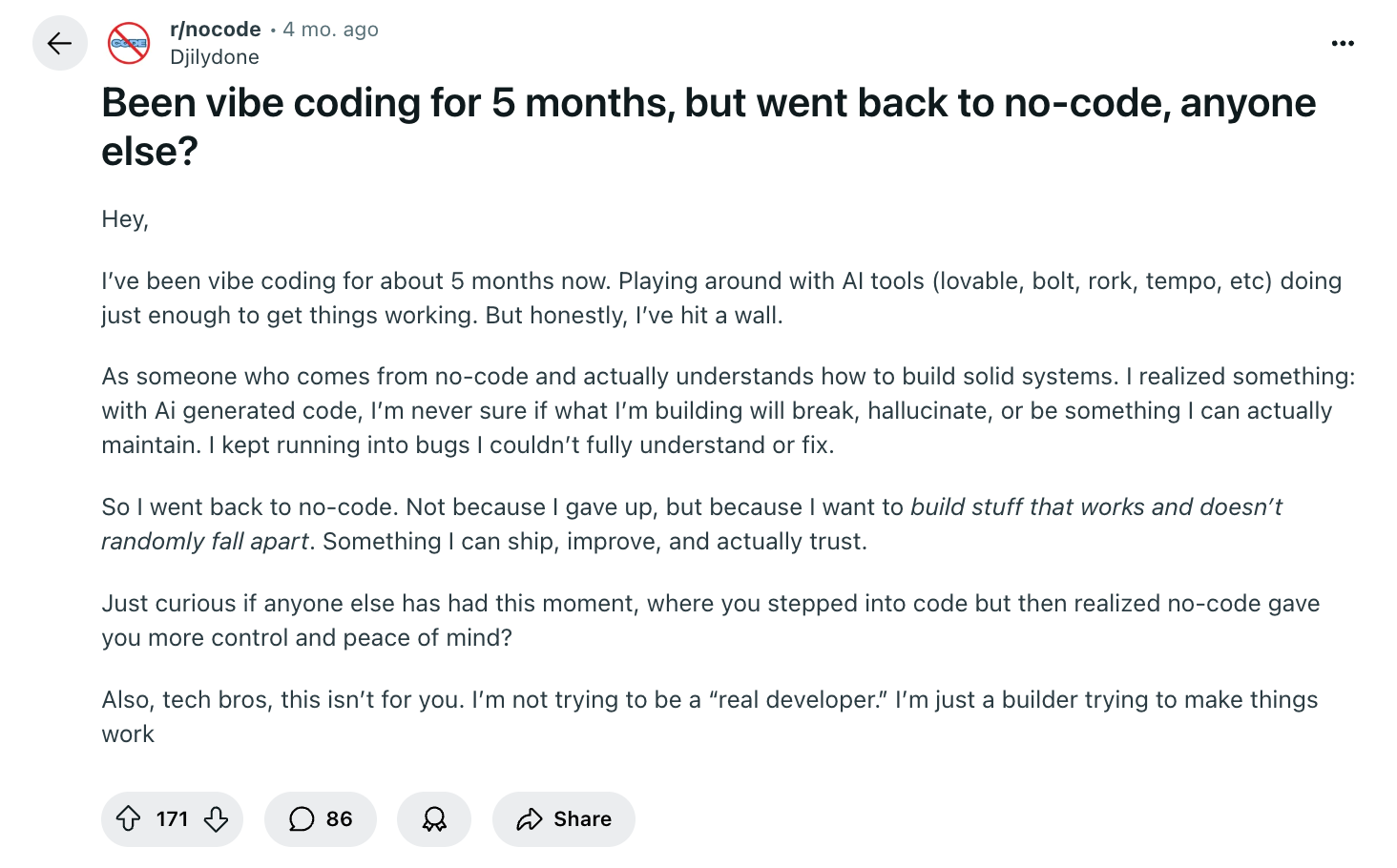
The reason was straightforward: the instability of AI-generated results (hallucinations). Debugging and fixing errors was exhausting, and long-term maintenance was even more daunting.
For many who tested Vibe Coding in real-world projects, the conclusion was clear: no-code remains the more stable and controllable option.
So maybe the real question isn’t which one is better, but when to use each.
💬 Hey, you’re reading the NocoBase blog. NocoBase is the most extensible AI-powered no-code/low-code development platform for building enterprise applications, internal tools, and all kinds of systems. It’s fully self-hosted, plugin-based, and developer-friendly. → Explore NocoBase on GitHub
How to Choose?
I’m increasingly convinced that Vibe Coding won’t replace no-code. Instead, they’re more like two parallel paths—each with its own best use cases.
Vibe Coding works best for small, fast projects.
Think of a personal homepage, a simple utility, or a quick idea you want to bring to life—something that just needs to be generated quickly without complex logic.
No-code (beyond simple website builders) is better suited for complex, structured applications.
Examples include enterprise CRMs, approval systems, and data management platforms—apps that require collaboration, role-based permissions, data consistency, and long-term maintenance. In these scenarios, the stability and control that no-code platforms provide are critical.
What’s even more interesting is that the line between the two is blurring.
Many no-code platforms are now integrating AI features, allowing users to generate pages, fields, or workflows through natural language—while still retaining the consistency of a no-code framework.
So the real decision comes down to your project’s stage, the complexity of your requirements, and the resources of your team. These factors determine whether Vibe Coding, no-code, or a combination of both will be the right fit.
Next, I’ll recommend tools across three categories: Vibe Coding platforms, no-code platforms, and hybrid solutions that combine both.
| Product | Open Source | Category | AI Features | UI Building | Backend Logic | Best Use Cases | Team Collaboration | Learning Curve |
|---|---|---|---|---|---|---|---|---|
| Cursor | ❌ | Vibe Coding | ✅ Deep AI integration | ❌ (IDE code only) | ✅ AI-assisted coding | Small utilities, rapid prototyping | Medium (Git-based) | Moderate |
| v0.app | ❌ | Vibe Coding | ✅ Natural language UI | ✅ Auto-generated | ❌ | Landing pages, component sketches | ❌ | Easy |
| Lovable | ❌ | Vibe Coding | ✅ Conversational generation | ✅ Auto-generated | ❌ | Websites, small sites | ❌ | Very Easy |
| NocoBase | ✅ | No-Code | ⚠️ AI assistants in progress | ✅ Block-based visual builder | ✅ Data modeling + permissions | CRM, approval flows, internal business apps | ✅ | Moderate |
| Retool | ❌ | No-Code | ✅ AI assistant & LLMs | ✅ Drag-and-drop UI | ✅ DB/API/JS integration | Ops dashboards, admin systems | ✅ | Moderate-High |
| Budibase | ✅ | No-Code | ❌ | ✅ Structured UI | ✅ Forms + workflows | Form systems, approval portals | ✅ | Moderate |
| ToolJet | ✅ | Hybrid | ✅ Prompt-to-code | ✅ Drag-and-drop + scripting | ✅ Workflows + JS | Lightweight internal tools with AI features | ✅ | Moderate |
| Bubble | ❌ | Hybrid | ✅ Plugins + AI assistant | ✅ Highly customizable UI | ✅ Workflows + data | SaaS apps, AI-powered web apps | ✅ | Moderate |
| Flowise | ✅ | Hybrid | ✅ Native LLM toolchain | ❌ (requires external UI) | ✅ AI workflows | RAG systems, AI Q&A backends | ✅ | Moderate-High |
Vibe Coding
Cursor
Website:https://www.cursor.sh
Overview
Cursor is an IDE built specifically for the AI coding experience. It’s not just a wrapper around Copilot, but one of the flagship tools representing the “Vibe Coding” approach.
Key Features
- Code-as-conversation workflow: Cursor goes beyond simple autocomplete. You can highlight code blocks and directly edit them through conversation, generate commit messages, and even restructure architecture logic. Compared to Copilot, it feels more proactive and controllable.
- Stronger context awareness: Unlike VSCode plugins, Cursor captures project context more comprehensively. This makes it especially effective with long files or multi-module projects, where it can better understand overall structure.
- Built-in version rollback: Every AI-generated change automatically produces a diff, so you can roll back with a single click—reducing the risk of AI “hallucinations” breaking your code.
- Reusable prompt marketplace: Cursor is building a dedicated AI prompt marketplace, similar to VSCode snippets. Developers can reuse prompts crafted by others to improve AI output.
Best Use Cases
- Rapid prototyping to quickly test whether an idea is feasible (classic Vibe Coding use case).
- Refactoring or rewriting existing code, such as updating style components or APIs.
- A “sandbox” for exploring how far AI can assist in coding tasks.
Limitations
- No self-hosting: Not suitable for enterprises or privacy-sensitive projects requiring on-premise deployment.
- Human judgment required: While Cursor generates logically correct code, it won’t make architecture decisions or handle performance optimization for you.
- Risk of skill gaps: Heavy reliance on AI generation may turn developers into “prompt operators” rather than true system designers.
v0.app
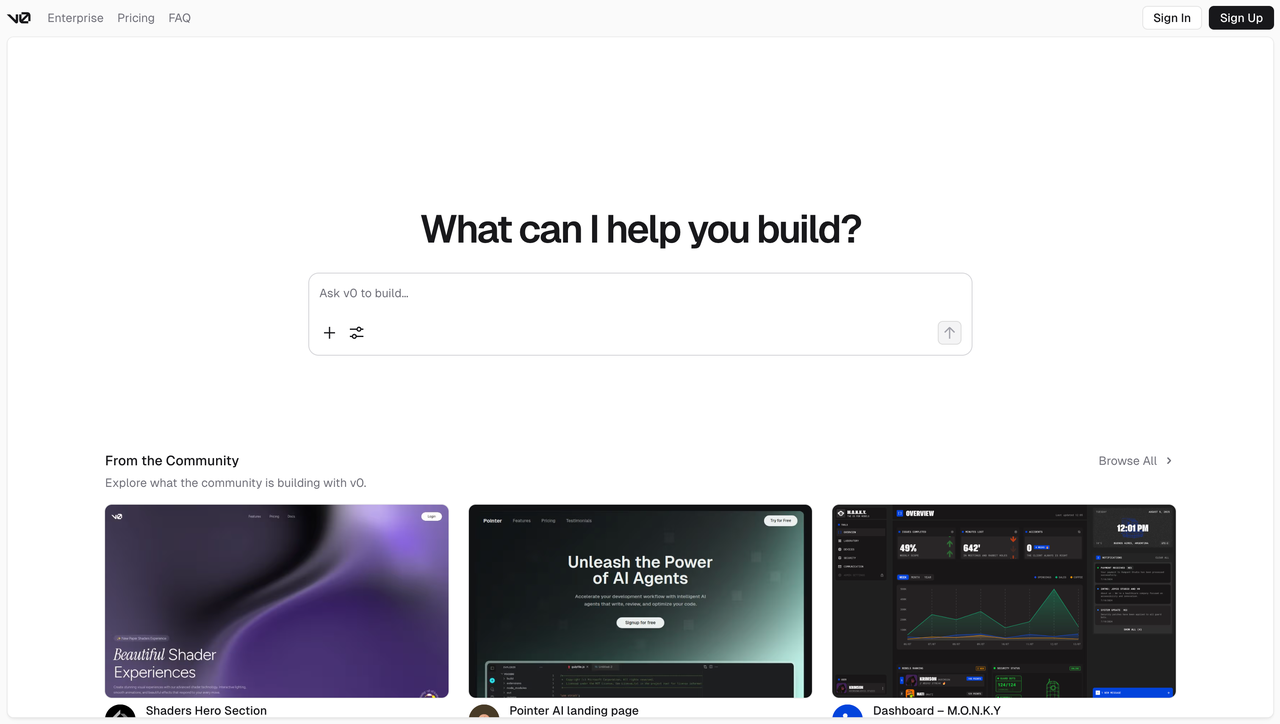
Website:https://v0.dev
Overview
Built by Vercel, v0 is an AI-powered UI generator that lets you create frontend pages from natural language. It’s one of the closest tools to the “design-to-code” vision within the Vibe Coding space.
Key Features
- Instant UI generation: Simply describe what you need—e.g., “a blog page with a search bar and results list”—and v0 instantly produces responsive, semantic code (using shadcn/ui + Tailwind CSS).
- Code-first, no black box: Output is standard React + JSX, fully open and controllable—no vendor lock-in or hidden runtime dependencies.
- Conversational iteration: You can refine designs with prompts like “make the navbar background black” or “add a subscribe button”. v0 keeps the style consistent while applying changes.
- Seamless Vercel integration: Generated pages can be deployed, imported into projects, or shared with your team in one click—making the workflow especially developer-friendly.
Best Use Cases
- Prototypes, campaign sites, or landing pages with attractive design but simple logic.
- Generating UI drafts so developers can focus on business logic.
- Component generation within existing frontend projects to speed up development.
Limitations
- Frontend only: v0 does not handle complex backend interactions. Business logic and data binding must be implemented manually.
- Style uniformity: Current outputs are heavily tied to the shadcn/ui library. While modern-looking, it may not suit projects with strict custom design systems.
- Limited team collaboration: v0 is still geared toward individual developers; features like multi-user editing, permissions, or version management are not yet supported.
Lovable
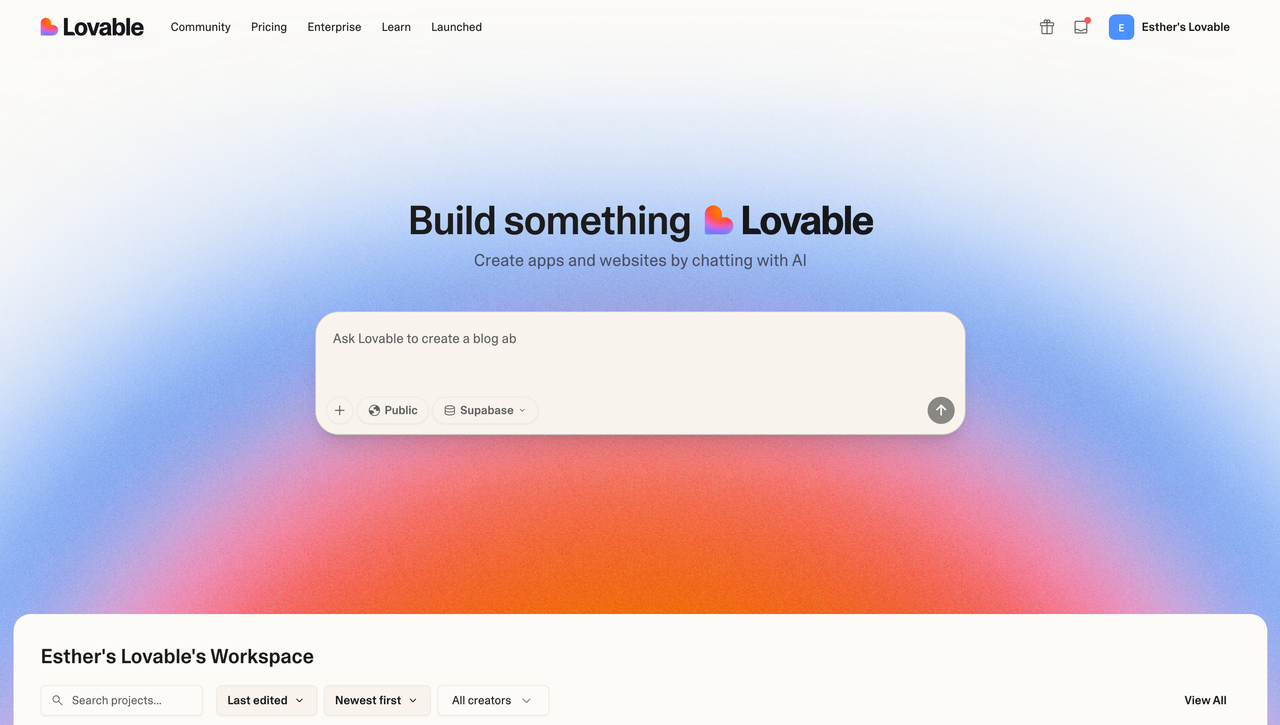
Website:https://lovable.so
Overview Lovable takes a more conversational approach: you describe what you need in natural language, and it generates a complete website for you.
Key Features
- Streamlined “generate → publish” workflow: Just describe your requirements—e.g., “I need a home services website with a carousel banner”—and Lovable automatically builds page layouts, text content, image styles, and even color schemes.
- Optional AI Agents: Beyond basic site generation, Lovable offers dozens of prebuilt AI agents such as SEO Consultant, Design Assistant, or Copywriting Generator to cover tasks outside of pure development.
- Finished product delivery: The goal isn’t to give you a dev environment, but a ready-to-use site. You can export the HTML/CSS/JS or host it directly.
- Zero learning curve: Designed for non-technical users, the experience is closer to “ChatGPT for websites” than a traditional builder.
Best Use Cases
- Early-stage startups validating ideas with a quick website or landing page (e.g., booking pages, blogs, event sites).
- Content-driven projects like portfolios, marketing pages, or course introductions.
- Freelancers and non-technical creators who want a smarter alternative to traditional site builders.
Limitations
- AI-styled outputs: Generated sites often carry a “templated” AI look in both design and copywriting—great for MVPs, but not ideal for polished brand websites.
- No complex logic: Lovable doesn’t support structured features like data modeling, permission control, or backend workflows, making it unsuitable for internal tools or system-level apps.
- Bound by conversational scope: Once requirements move beyond simple rules—like membership systems or dynamic forms—Lovable quickly hits its limits.
No-Code
NocoBase
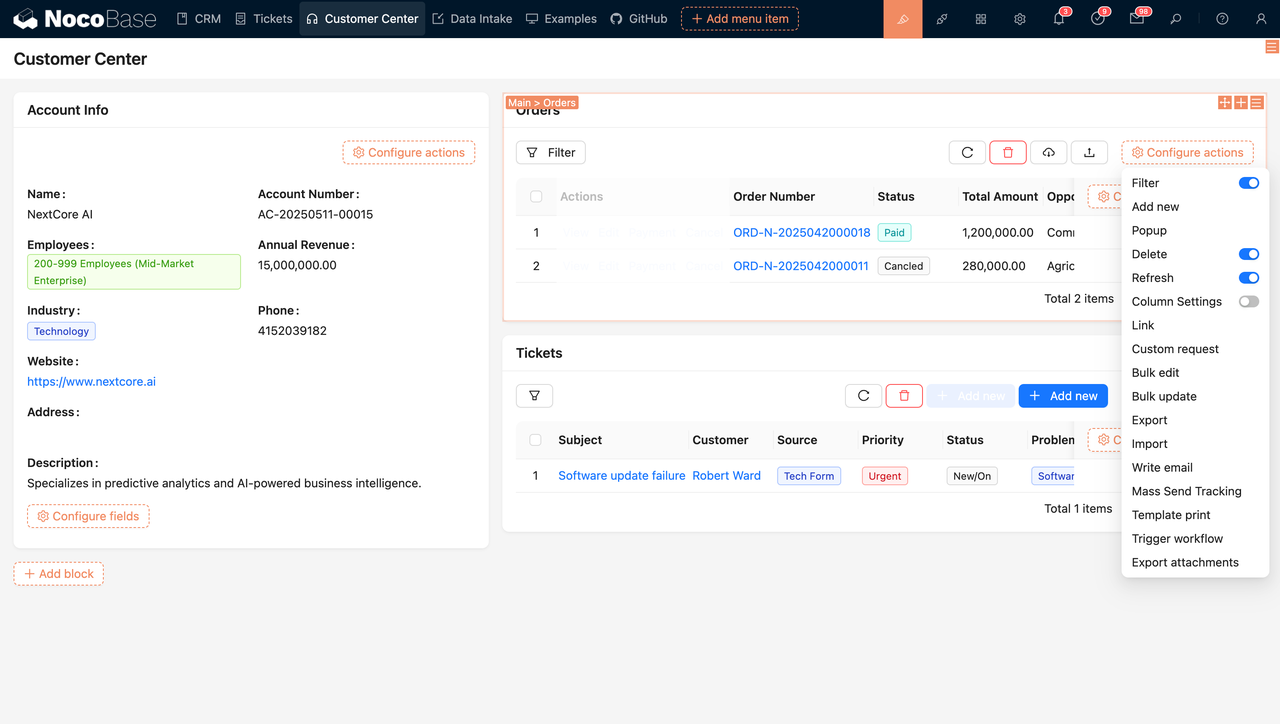
Website:https://www.nocobase.com
Overview
NocoBase is a data-model–driven open-source no-code platform built for mid-to-large scale internal systems. With high extensibility and fine-grained access control, it excels in complex business scenarios where Vibe Coding tools fall short.
Key Features
- Data modeling at the core: Unlike table-centric no-code tools (e.g., Airtable-style platforms), NocoBase follows a framework-like approach. It emphasizes entity relationships, field structures, and clean separation of business logic—ideal for building complex business applications.
- Flexible plugin ecosystem: Everything is modularized as plugins—from user authentication, role-based permissions, and workflows to file storage and even AI assistants. Teams can tailor their stack to specific needs.
- Frontend–backend separation + block-based UI: Build UIs like Lego blocks, customize components, or integrate APIs. The result is a system that is both flexible and controlled.
- Granular permissions: With field-level and row-level access control, paired with frontend logic, it’s easy to configure role-specific views—something Vibe Coding tools cannot realistically achieve.
Best Use Cases
- Enterprise-grade internal systems: CRM, ticketing, asset management, approval platforms.
- Self-hosted business platforms: For teams that need security, control, and custom features without relying on cloud vendors.
- Tech teams blending no-code + code: Quickly build core systems with no-code, while keeping extensibility for custom development.
Limitations
- Steeper learning curve: Compared to lightweight tools like v0.app or Lovable, NocoBase is better suited for users with some development or product design experience.
- Not a website builder: It’s not intended for content-heavy sites, brand websites, or simple frontend projects.
- Plugin ecosystem still maturing: As an open-source project, the marketplace of plugins and templates is growing but not yet at the level of commercial platforms.
Retool

Website:https://retool.com
Overview
Retool is an all-in-one platform for building enterprise-grade internal tools. Its strength lies in “connect everything + launch fast,” with powerful data integration and business logic capabilities.
Key Features
- Effortless data and API connections: Retool natively supports dozens of databases (PostgreSQL, MongoDB, Snowflake, etc.) and third-party APIs (Stripe, Slack, Salesforce, and more). Configure once, then drag and drop components to build functional interfaces.
- Rich UI components with high flexibility: Comes with a wide library of production-ready components (tables, charts, forms, date pickers, etc.), supporting state management and logic binding—perfect for building business-ready frontends.
- Strong scripting capabilities: Beyond visual building, you can use JavaScript for data transformation, validation, or inter-component logic—ideal for complex workflows.
- AI-powered development assistance:
- Query & code generation: Use prompts inside SQL or JS editors to generate queries and scripts, reducing repetitive work.
- AI component generator: Describe a page in natural language and Retool creates it automatically.
- LLM integrations: Built-in connectors for vector databases (Pinecone, Weaviate, etc.) and support for OpenAI, Cohere, Anthropic—making it easy to add AI search, Q&A, or document intelligence features.
- Enterprise-ready security & deployment: SSO, audit logs, and self-hosted deployment options make Retool a good fit for organizations with strict compliance or security requirements.
Best Use Cases
- Quickly building structured internal systems such as CRMs, approval workflows, BI dashboards, and ops panels.
- Creating business tools enhanced with AI—for example, customer support backends or AI-powered analytics systems.
- Small-to-mid sized dev teams using Retool instead of building internal tools from scratch.
Limitations
- High pricing: The commercial edition can be expensive, especially with per-user pricing, which may be prohibitive for startups or budget-conscious teams.
- Not fully no-code: While the UI builder is visual, advanced logic almost always requires JavaScript, making it unsuitable for users with no coding background.
- Functional, not flashy: The design leans toward utility and efficiency. While great for internal tools, it’s less suited for customer-facing UIs where polished aesthetics matter.
Budibase
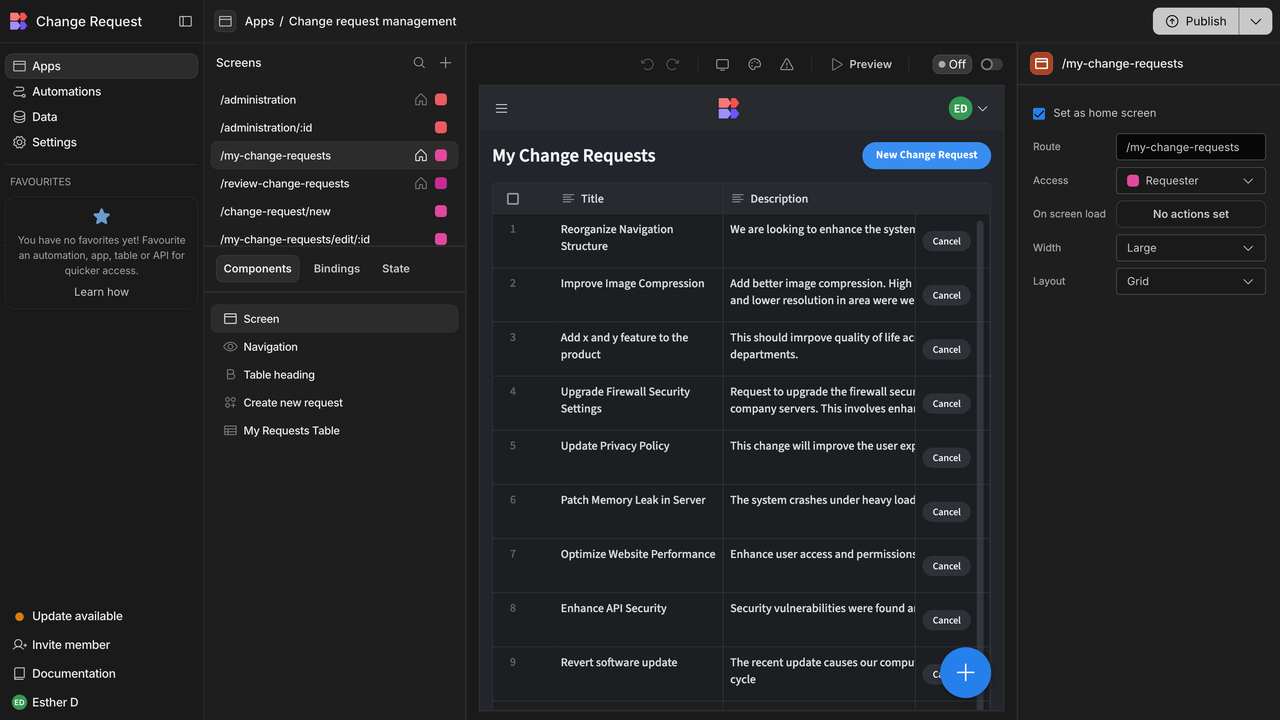
Website:https://budibase.com
Overview
Budibase is an open-source low-code platform focused on building forms, approval flows, and internal portals. It emphasizes self-hosting + rapid deployment, giving it a distinct advantage for organizations building internal information systems.
Key Features
- Wide data source support + built-in database: Connect to PostgreSQL, MySQL, REST APIs, Airtable, and more—or use Budibase’s built-in database for zero-configuration modeling and UI building.
- Strong in forms + workflows: Ideal for structured business scenarios like approval flows, data entry, and project tracking. Supports field validation, conditional display, and automated state changes.
- Clear role & permission control: Assign different views and action rights per role, enabling secure multi-role use within organizations.
- Self-hosting and private deployment: Fully open-source with Docker deployment, making it attractive for teams that require data sovereignty.
- Lightweight code extensibility: Provides JavaScript slots for cases where visual logic isn’t enough, allowing developers to adapt to specialized business needs.
Best Use Cases
- Internal approval systems, task portals, customer records, and asset tracking tools.
- Utility-style projects with clear data structures but limited UI complexity.
- Small-to-mid sized teams with light development skills, looking to deliver internal tools at lower cost.
Limitations
- Restricted UI flexibility: Great for structured forms and tables, but not for highly customized frontends.
- Weaker ecosystem: Compared to Retool or NocoBase, plugin and template ecosystems are still in early development.
- Minimal AI integration: Unlike Retool, Budibase has yet to incorporate LLM or AI-powered workflows—its focus remains on traditional no-code building.
Hybrid
ToolJet

Website:https://www.tooljet.com
Overview
ToolJet is an open-source low-code platform built around drag-and-drop UI + multi-data source integration. In recent years, it has also introduced AI features, making it a strong example of how hybrid platforms are evolving.
Key Features
- Visual building + wide data source support: Connect to MongoDB, PostgreSQL, MySQL, REST APIs, and more than a dozen other sources. Bind data to components through a visual editor to quickly build dashboards, admin panels, or customer management systems.
- Intuitive drag-and-drop UI: Comes with a rich set of components (tables, buttons, charts, etc.) and allows custom JavaScript scripting for interaction logic—lowering the barrier for frontend-heavy projects.
- AI-enhanced development: Supports prompt-based page and logic generation, giving non-developers an easier entry point.
- Open-source + self-hosting: Fully open-source with Docker deployment support, suitable for enterprises or teams with strict security and compliance needs.
- Role-based access control: Fine-grained permissions for different users and roles, enabling effective collaboration on mid-sized projects.
Best Use Cases
- Quickly building structured, data-driven internal systems (CRM, CMS, approval workflows).
- Technical teams that need customization without writing full frontend and backend code.
- Startups or AI-focused teams looking to embed AI into business UIs and validate product ideas.
Limitations
- AI still at augmentation stage: Primarily helps with query generation and code snippets; it doesn’t yet deliver the “build an app from scratch” experience of true Vibe Coding tools.
- Limited complex interactions: While JS scripting is supported, building highly customized UIs or managing advanced state logic remains harder compared to fully coded or highly programmable frameworks.
Bubble
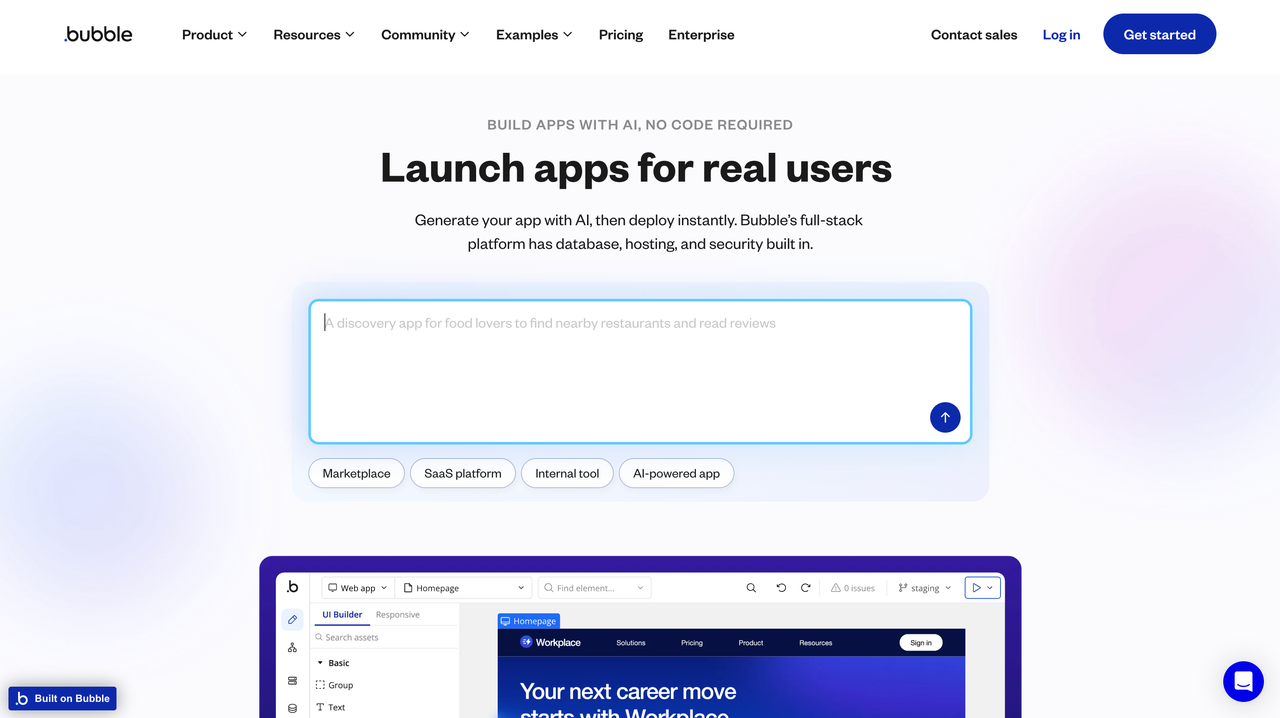
Website:https://bubble.io
Overview
Bubble is one of the most established full-stack no-code platforms, covering everything from UI design to database logic in a fully visual workflow. In recent years, it has expanded through plugins and API integrations to embrace AI, moving closer to Vibe Coding scenarios.
Key Features
- Full-stack development without code: Bubble supports page design, database modeling, workflow automation, user authentication, and plugin integration—making it one of the few platforms capable of end-to-end app building with no coding required.
- Highly visual + responsive design: Drag and drop elements to build pages, while configuring interaction logic (conditions, states, dynamic data). Well-suited for web apps that require both frontend and backend logic.
- AI capabilities:
- Bubble AI Assistant: Add workflows or UI components via natural language, making development more conversational.
- GPT plugin ecosystem: Quickly integrate OpenAI APIs for content generation, Q&A, form autofill, and more.
- LangChain & RAG integration (experimental): Some advanced users are using Bubble as a frontend layer for RAG-powered assistants.
- Strong community + template marketplace: Hundreds of templates and plugins available for reuse and customization, accelerating time-to-market.
Best Use Cases
- Building complete SaaS applications, user portals, booking systems, or education platforms—especially for startups going from 0 to 1.
- Creating MVPs that combine strong UI/UX with data workflows.
- Developing AI-powered apps such as Q&A bots, AI writing tools, or conversational assistants.
Limitations
- Steeper learning curve than expected: Despite being no-code, Bubble’s workflow and permissions setup can be complex for beginners.
- Weak self-hosting support: Bubble is closed-source and only available as a hosted service, limiting its adoption for enterprises or data-sensitive projects.
Flowise
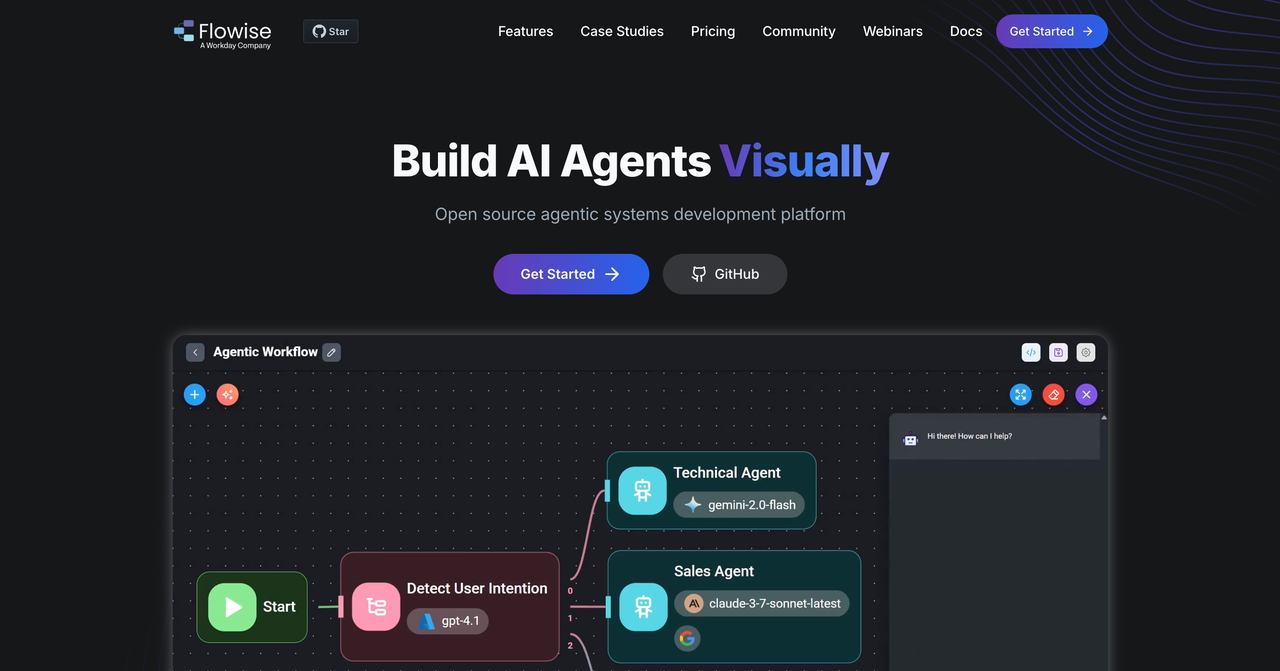
Website:https://flowiseai.com
Overview
Flowise is an open-source visual builder for LLM-powered applications. Designed around drag-and-drop AI components, it can serve either as an AI extension to no-code platforms or as a standalone engine for AI-driven business tools.
Key Features
- Node-RED–style workflow builder: Assemble pipelines by chaining together modules such as LLMs (OpenAI, Claude, etc.), vector databases (Pinecone, Chroma, Weaviate), text-processing nodes, and API inputs/outputs—like building blocks for complete AI apps.
- Backend logic layer for AI: Flowise doesn’t handle UI. Instead, it provides the logic and workflow layer behind AI apps, which you can expose as APIs to any frontend (e.g., Bubble, ToolJet, Retool).
- Lightweight + self-hosting friendly: Runs with just a few commands, no registration or cloud dependency—perfect for internal testing and integration.
- Covers core LLM use cases: Supports chatbots, RAG pipelines, document Q&A, summarization, JSON generation, and knowledge-base querying—well-suited for vertical AI business tools.
Best Use Cases
- Adding an AI “intelligence layer” to existing no-code/low-code platforms.
- Building reusable AI services (e.g., FAQ APIs, document summarizers, semantic search APIs).
- Technical teams experimenting with different LLM toolchains, as part of an AgentOps workflow stack.
Limitations
- No UI layer: Flowise is not an end-to-end no-code tool; it needs to be paired with a frontend platform.
- Workflow complexity at scale: While drag-and-drop lowers the barrier, debugging large node-based workflows still requires technical understanding of inputs/outputs.
- Not beginner-friendly: Compared to “plug-and-play” tools like Bubble or Lovable, Flowise is more of a developer toolkit than a consumer-friendly builder.
Conclusion
Whether you’re an indie developer testing a new idea or part of a technical team building complex enterprise systems, you’ve probably realized something:Vibe Coding and no-code aren’t an either–or choice.
In more and more scenarios, the focus is shifting away from writing code toward solving problems.
Hopefully this article helps you find the tools that best fit your needs.
If you’re already building with these platforms, I’d love to hear about your experience—and feel free to share this article with others who might find it useful. ❤️
Related reading:
